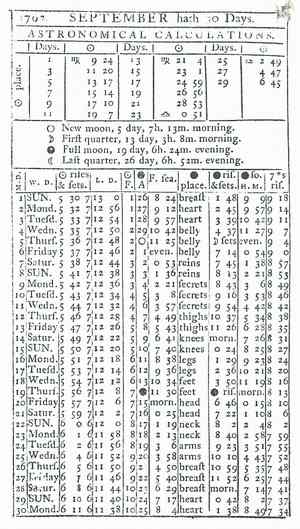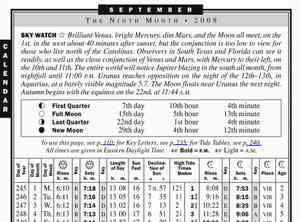One of the long-standing features of The Old Farmer’s Almanac are the so-called “left-hand calendar pages.” These pages, one for every month, contain astronomical timetable information — sunrise, sunset, length of day, moonrise, moonset, moon’s place in the heavens, and so on.
And when I say “long-standing,” I mean long-standing, as these tables have been there since the first edition of The Old Farmer’s Almanac was published in 1792, two hundred and fifteen years ago. Here’s the September 1793 left-hand calendar page:

While the columns have changed a little, and the typeface is different these days, that 1793 page is substantially the same in format as the ones you’ll find in the 2008 The Old Farmer’s Almanac that went on sale last week:

One of the limitations of ye olde print world is that these pages have been pegged to a specific location; for the national edition of the Almanac in the U.S. it’s Boston; for Canada it’s Ottawa. This means that if you live elsewhere, as most people do, you need to use conversion tables printed in the back of the book to correct for your location.
For the past couple of months I’ve been working on a web-based application that does away with this limitation, allowing the left-hand calendar pages to be generated for any location in the U.S. or Canada. This application — dubbed My Local Almanac — went live an hour ago, and I’m quite proud of it.
Take a look at this sample page for Dublin, NH and you’ll see that it bears an awful lot in common with that page above from 215 years ago.
Needless to say the process of creating this application has taken me deep into the heart of astronomy, creating algorithms to quickly compute the various columns of information. I’ve learned about the great zodiac debate (sidereal vs. tropical; or “do we use the heavens as they were a long time ago, or as they are tonight?”), about places with 5 high tides a day, and about how the moon sometimes neither rises nor sets in the north. I’ve learned about the Equation of Time and about how it’s noon when the sun is directly overhead, but only if your longitude is along the Standard Time Meridian for your time zone.
I’ve also learned a lot about handcrafting PDF files (EZPDF I bow before your excellentness) and how to effectively deliver products that take 2 or 3 minutes to construct behind the scenes.
All that’s left to do now is sit beside the terminal waiting for the first customer to come along and make the first purchase. Perhaps it could be you: My Local Almanac.
 I am
I am
Comments
Very nice. Is the Boston-ness
Very nice. Is the Boston-ness of the tides temporary, a misprint, or is even non-local tide info valuable to a New Hampshirean?
We use the nearest tide
We use the nearest tide station if one is found within 100 miles in our database. Otherwise we use Boston for the east coast, San Francisco for the west coast, and Halifax and Vancouver for the Canadian east and west coasts.
Add new comment